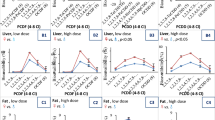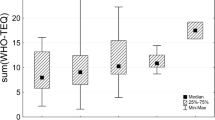Abstract
Contents of 2,3,7,8-tetrachlorodibenzo-p-dioxin (TCDD) and of 16 further congeners – polychlorinated dibenzodioxins and dibenzofuranes (PCDD/PCDF) – were determined in lipids of adipose tissue and of livers of 3 stillborns and of 17 infants (0.43–44 weeks old) who died from sudden infant death syndrome. International toxic equivalents (I-TEq) calculated for the sum of TCDD together with all of the 16 congeners (1.55–29.63 ng/kg lipids of adipose tissue, n = 20; 2.05–57.73 ng/kg liver lipids, n = 19) were within the range of or lower than the values published for adults. TCDD concentrations in lipids of breast-fed infants were higher (0.38–4.1 ng/kg lipids of adipose tissue, n = 9; 0.49–3.9 ng/kg liver lipids, n = 8) compared to non breast-fed subjects (0.16–0.76 ng/kg lipids of adipose tissue, n = 8; 0.29–0.71 ng/kg liver lipids, n = 7). Neither I-TEq values nor TCDD concentrations exceeded values published for adults. Since even in stillborns PCDD/PCDF were found (I-TEq, 9.70–10.83 ng/kg lipids of adipose tissue, 6.17–8.83 ng/kg liver lipids; TCDD, 1.3–2.1 ng/kg lipids of adipose tissue, 0.76–1.5 ng/kg liver lipids; n = 3), transplacental exposure has to be deduced. All of the findings concerning TCDD concentrations in the organism become intelligible on the basis of a physiological toxicokinetic model which was developed to describe the body burden of TCDD for the entire human lifetime in dependence of TCDD uptake from contaminated nutrition. The model reflects sex and age dependent changes in the following parameters: body weight, volumes of liver, adipose and muscle tissue, food consumption, and excretion of faeces. TCDD is supposed to be taken up orally, to be distributed freely in lipids of the organism and to be eliminated unchanged by excretion in lipids of faeces as well as by metabolism in the liver. The model was used to predict the half-life of elimination of TCDD (4 months in newborns increasing to ∼5 years in adults) and concentrations of this compound in lipids of adipose tissue, blood, liver and faeces at different ages. Furthermore, the influence of breast-feeding on the TCDD burden of a mother, her milk and her child was simulated. The model was validated by means of own data gained in adipose tissue and livers of infants and also using a series of values measured by other authors in mother's milk and in tissues and faeces of infants and adults. Predictions as well as experimental findings demonstrate a distinct increase in the TCDD body burden of breast-fed infants. Generally, it can be concluded for the excretion of unchanged, non volatile, non protein bound highly lipophilic compounds that their half-life is short in infants (∼5 months) and increases to ∼10 years reached between 40 and 60 years of age.
Similar content being viewed by others
Author information
Authors and Affiliations
Additional information
Received: 30 July 1996 / Accepted: 30 October 1996
Rights and permissions
About this article
Cite this article
Kreuzer, P., Csanády, G., Baur, C. et al. 2,3,7,8-Tetrachlorodibenzo-p -dioxin (TCDD) and congeners in infants. A toxicokinetic model of human lifetime body burden by TCDD with special emphasis on its uptake by nutrition. Arch Toxicol 71, 383–400 (1997). https://doi.org/10.1007/s002040050402
Issue Date:
DOI: https://doi.org/10.1007/s002040050402




